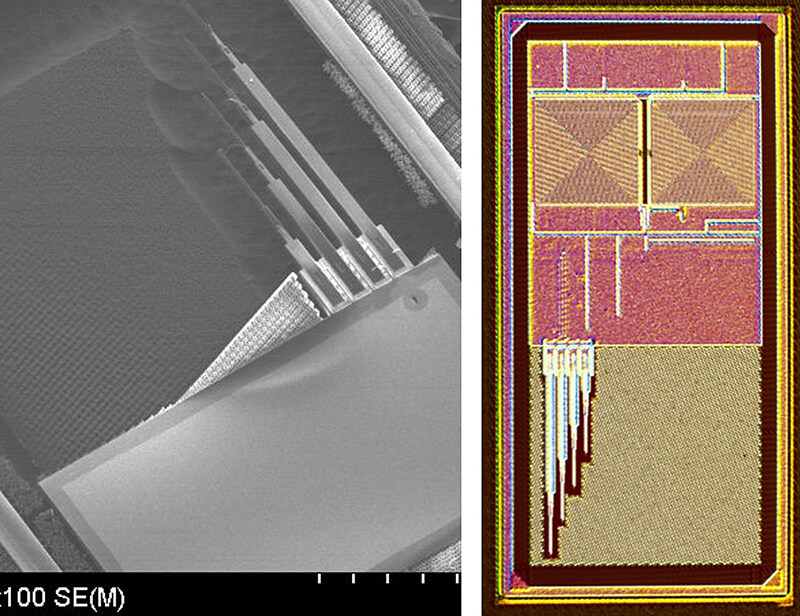July 18, 2018
Tiny electronic chip provides big boost to treat hundreds of millions with brain and central nervous system disorders
 These figures show pre- and post-fabricated wireless neural probes chip micrograph. Purdue University researchers developed an electronic chip that can read signals from several nerve endings and wirelessly transmit them without needing a battery or any other off-chip component. (Images provided)
Download image
These figures show pre- and post-fabricated wireless neural probes chip micrograph. Purdue University researchers developed an electronic chip that can read signals from several nerve endings and wirelessly transmit them without needing a battery or any other off-chip component. (Images provided)
Download image
WEST LAFAYETTE, Ind. – Purdue University researchers have created an electronic chip that may provide improved support for the hundreds of millions of people worldwide the World Health Organization says are affected by neurological disorders.
The Purdue researchers developed an electronic chip that can read signals from several nerve endings and wirelessly transmit them without needing a battery or any other component. Energy is created by an on-chip antenna similar to the technology used to wirelessly charge smartphones.
“This invention opens up even greater life-saving research into understanding the brain and central nervous system, various neural diseases and neuro-prosthetics,” said Saeed Mohammadi, an associate professor in Purdue’s School of Electrical and Computer Engineering, who helped lead the research. “Our breakthrough is that this chip is very small, about the size of a piece of dust, and can be made flexible for future brain implant applications.”
The electronic chip integrates with neural sensors and uses a remotely powered electronic system to wirelessly transmit the brain signals to a computer. The system provides support for people with neural deficiencies and those with severed nerves.
“The main challenges are to operate such a wireless neural interface system with a small and flexible chip at very low power and yet high data rate,” Mohammadi said. “We need a high data rate to be able to read signals from thousands of neurons using a single implant chip. At the same time, we need to operate the system at very low power for safety and size reasons.”
Purdue’s innovative low-power circuit design is created using a typical electronic chip received from a semiconductor manufacturing company that is then processed at the university to carve out the microelectrodes for the neural interface system.
“We can perhaps provide a technology that is more bio-compatible with brain tissues and can be implanted in the human brain or at nerve endings with much better success rate,” Mohammadi said.
Researchers worked with the Purdue Office of Technology Commercialization on the innovation. The research team is looking for investors and industrial partners for the technology.
About Purdue Office of Technology Commercialization
The Purdue Office of Technology Commercialization operates one of the most comprehensive technology transfer programs among leading research universities in the U.S. Services provided by this office support the economic development initiatives of Purdue University and benefit the university's academic activities. The office is managed by the Purdue Research Foundation, which received the 2016 Innovation and Economic Prosperity Universities Award for Innovation from the Association of Public and Land-grant Universities. For more information about funding and investment opportunities in startups based on a Purdue innovation, contact the Purdue Foundry at foundry@prf.org. For more information on licensing a Purdue innovation, contact the Office of Technology Commercialization at innovation@prf.org. The Purdue Research Foundation is a private, nonprofit foundation created to advance the mission of Purdue University.
Purdue Research Foundation contact: Chris Adam, 765-588-3341, cladam@prf.org
Source: Saeed Mohammadi, saeedm@purdue.edu

